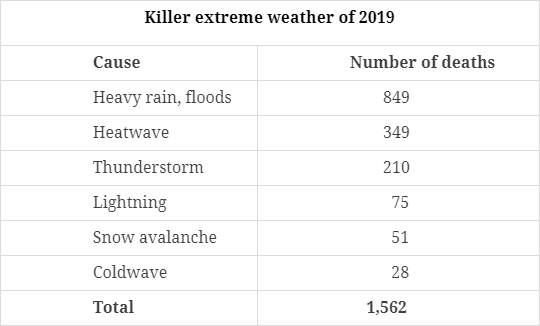Statement on Climate of India during 2019: IMD | 08 Jan 2020
Why in News
The India Meteorological Department (IMD) has released the ‘Statement on Climate of India during 2019’.
Key Findings
- Deaths due to weather extremes: 2019 was a year of extremes – heat, cold, rain, and cyclones for India, killing a total of 1,562 people. Last year, the total number of deaths caused due to similar weather vagaries was 1,428.
- The state-wise death toll caused due to various extreme weather events: Maharashtra (231), Jharkhand (138), Uttar Pradesh (135), Rajasthan ( 94), Kerala ( 86), Odisha (64), Jammu and Kashmir, Ladakh ( 51), Karnataka (43), Himachal Pradesh (27) and Madhya Pradesh (24).
- Rainfall: The rainfall amounts during both the southwest monsoon (June to September) and northeast monsoon (October to December) remained 109% of the Long Period Average (LPA). That is, the country recorded excess rainfall during the entire year, making it an extremely wet year in recent times, when both monsoons reported above normal rain for the seasons.
- Long Period Average is a 50 year average of India’s monsoon rains. The current LPA is 89 cm, based on the average rainfall over the years 1951 and 2000.
- Rise in Temperature
- The mean temperatures remained 0.36 degrees above normal, making 2019 the seventh hottest year ever recorded.
- The decade 2011 – 2019 remained the warmest on record for the country, when the annual mean temperature remained 0.36 degree above normal.
- Since 1901, India has warmed by 1 degree Celsius. Whereas, the rise in minimum temperature was 0.22 degrees in the century.
- Number of Cyclones: 2019 was exceptional for the number of cyclones that hit India’s east and west coasts.
- Previously, similar cyclonic activity was reported in the Indian Ocean only during 1893, 1926, 1930, and 1976. During these years, cyclones formed both in the Arabian Sea and the Bay of Bengal put together numbered to ten in a calendar year.
- Notably, an active Arabian Sea saw more cyclonic storms than the Bay of Bengal during 2019. It was only for the second time in 117 years that the Arabian Sea saw such intense and frequent cyclones.
- In 2019, eight cyclonic storms formed over the north Indian Ocean, of these, five — Cyclones Vayu, Hikka, Kyarr, Maha and Pavan originated in the Arabia Sea, which is normally calmer. On the contrary, the Bay of Bengal reported less than normal number of cyclones. The three cyclones formed here were — Cyclones Pabuk, Fani, Bulbul.
- The Bay of Bengal sees an average of five cyclones each year, making 2019 a year when the Arabian Sea dominated.
- Coldest Winter
- The winter of 2018-2019 was one of the coldest in the northern hemisphere.
- Jammu and Kashmir, Ladakh reported 51 deaths triggered by snow avalanche in 2019.
India Meteorological Department
- IMD was established in 1875.
- It is an agency of the Ministry of Earth Sciences of the Government of India.
- It is the principal agency responsible for meteorological observations, weather forecasting and seismology

